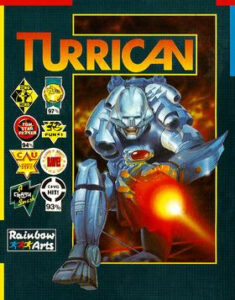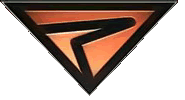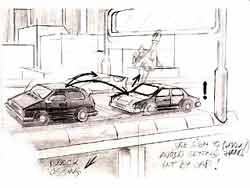Run-‘n-gun games are a staple of gaming. They’ve been around forever, and people never seem to get tired of blowing things up using incredible weapons with limitless ammo. It’s the American way! One of the most famous series in this genre, around almost since its inception, is that of the armored hero Turrican. He’s appeared on more platforms than you can shoot a spread gun at and has become something of a legend in Europe. He never really got the treatment he deserved in the U.S. until the 16-bit era and was recently slated to make a comeback in two separate games, neither of which will ever see the light of day due to a licensing entanglement of epic proportions and a creative dispute that made the series’ creator walk away forever.
A Bit of History
 Created by Manfred Trenz for the Commodore 64, Turrican made its debut in 1990. Trenz got his inspiration from such great games as Metroid and Psycho-Nics Oscar. The game was an instant success, and the original and a sequel were subsequently released by Factor-5 (of Rogue Squadron fame) on the Amiga, with Trenz doing the graphics work for both games. The games featured a warrior clad in the Turrican Assault Suit (Trenz got the name from Turricano, an Italian name he found in a phonebook) who fought his way through twelve stages against the MORGUL (Multiple ORGanism Unit Link). The battle suit came equipped with both a spread and laser gun and power ups gave you grenade bullets as well as a vertical flash that spread across the screen and unleashed massive damage. There was also a lightning whip that could be controlled with the joystick and whose range could be extended. Moreover, Turrican had the ability to morph into a “buzzsaw” (think of Metroid‘s morph ball) which made him invincible but could only be used three time per life.
Created by Manfred Trenz for the Commodore 64, Turrican made its debut in 1990. Trenz got his inspiration from such great games as Metroid and Psycho-Nics Oscar. The game was an instant success, and the original and a sequel were subsequently released by Factor-5 (of Rogue Squadron fame) on the Amiga, with Trenz doing the graphics work for both games. The games featured a warrior clad in the Turrican Assault Suit (Trenz got the name from Turricano, an Italian name he found in a phonebook) who fought his way through twelve stages against the MORGUL (Multiple ORGanism Unit Link). The battle suit came equipped with both a spread and laser gun and power ups gave you grenade bullets as well as a vertical flash that spread across the screen and unleashed massive damage. There was also a lightning whip that could be controlled with the joystick and whose range could be extended. Moreover, Turrican had the ability to morph into a “buzzsaw” (think of Metroid‘s morph ball) which made him invincible but could only be used three time per life.
The series attracted many fans with its huge levels and multiple secrets, as well as a wonderful soundtrack scored by Chris Hulsbeck (Secret of Monkey Island, Rogue Leader, Tunnel B1). Code Monkeys ported the original game to the Genesis, Game Boy, and PC-Engine; all released by Accolade under the Ballistic label. Though the Genesis version is the only complete port of the three, the soundtrack suffered due to the console’s limited sound chip. Turrican II was set to be released but was instead converted to Universal Soldier in order to tie in with Van Damme’s movie, with several questionable changes made to the game. The finished product was less than impressive, to say the least.
By now Trenz wasn’t involved with newer games in the series, as he preferred to work on 8-bit machines. He was responsible for the stellar but widely unknown Super Turrican for NES, which is essentially a blend of the first two games with some enhancements to the gameplay. It is notable that he alone was responsible for the concept & game design, program & text, graphics, and the music & sound effects. Quite a remarkable feat of programming.
Factor-5, on the other hand, went ahead with the franchise, releasing Mega Turrican/Turrican III for both the Genesis and the Amiga. The buzzsaw was now unlimited and Turrican received a Bionic Commando-style plasma rope that let him access platforms too high for jumping. The huge, Metroid-like stage designs of the first two games were abandoned in favor of standard scrolling levels. It was eventually adapted for the SNES, and several changes were made to bring it back to the style of the original games. For example, the plasma rope was replaced by an ice beam and the power up chests were changed back to invisible bonus boxes. The game received a sequel and though both are solid, competent entries in the series, they lack the polish of Mega Turrican. It should be noted that Super Turrican II featured some of the best boss battles in the series and sported a darker tone (the game was done from scratch as opposed to being ported). It was much more linear than any of the others and lacked the overall feel of the other games. Sadly, it was to be the final Turrican game ever released.
Time to Suit Up Again?
This is where things get interesting. In 1997, Factor-5 (who own the rights for Turrican in the USA and Europe outside of Germany) announced that they were working on another entry in the series, entitled Thornado, for the N64. Apparently, Rainbow Arts/THQ owned the rights to the Turrican brand in Germany and together with Manfred Trenz and Allvision, were planning to release a new Turrican game of their own for the PC. So, we were basically now going to get a new game by the original developer but without the brand name, as well as one with the brand name but done by a different developer. Regardless of how you looked at it, things seemed cheery for fans.
 Thornado, in the capable hands of long time Turrican developer Factor-5, was to give gamers two characters from which to choose. The title’s name came from the new wind-based weapons that were central to the action and could be used to blow enemies as well as obstacles from your path. In 2000, development was moved to the GameCube and was far enough along that a demo was shown at that year’s Spaceworld Show in Tokyo, Japan. It was supposedly quite impressive and showed great potential. Nothing was ever shown to the public and the 15 second demo that was shown was only to the press behnd closed doors.
Thornado, in the capable hands of long time Turrican developer Factor-5, was to give gamers two characters from which to choose. The title’s name came from the new wind-based weapons that were central to the action and could be used to blow enemies as well as obstacles from your path. In 2000, development was moved to the GameCube and was far enough along that a demo was shown at that year’s Spaceworld Show in Tokyo, Japan. It was supposedly quite impressive and showed great potential. Nothing was ever shown to the public and the 15 second demo that was shown was only to the press behnd closed doors.
In the Rainbow Arts/THQ camp, Trenz and Allvision were hard at work on their title, called Turrican 3D. It was going to have a third-person view (like the cancelled VectorMan) and its controls were to have been similar to that of Super Mario 64. The game was to have taken place in a huge, single world as opposed to separate levels. Development was pretty far along, and the game should have been released in 1999.
So Close but Yet So Far
With two different titles in the works, you’d think that the Turrican franchise was sure to continue, at least on the GameCube and PC. Sadly, it was not to be. Turrican 3D was the first to get the axe. Work was progressing at a decent pace when egos got the best of the project, causing a conflict that was neither explained nor justified. Development was suddenly stopped and no real reason as to why was ever given by THQ. The only information about the game’s demise came from Trenz himself, who, when asked if he had ever been involved in creative disputes with anyone, replied:
“Not really. The one and only big disagreement happened last year while developing Turrican 3D. The guys who did the 3D stuff wanted to make big money and did not really care about the quality of the product, a typical syndrome these days. End of the song: T3D got stopped and will never be released.”
This was essentially the end of Turrican 3D. No demos were ever released but some rare footage can be seen in a music video for the song Ballerspiel by the German group Abgehörte Telefonate. All that was ever seen by the public were some screen shots, such as the one featured here.
 As for Thornado, everything seemed to be moving ahead nicely until the game dropped off the industry radar. A glimmer of hope surfaced with news of Factor-5’s renewal of the trademark on April 22, 2004. However, no new information about Thornado has been made available and the game has since been removed from the developer’s web site. Rumors circulated in 2001 regarding its possible release on the Xbox following Factor-5’s drop of GameCube support last year. Everything depends on the game finding a publisher, although things look less and less likely as the life span of the current console generation draws to a close.
As for Thornado, everything seemed to be moving ahead nicely until the game dropped off the industry radar. A glimmer of hope surfaced with news of Factor-5’s renewal of the trademark on April 22, 2004. However, no new information about Thornado has been made available and the game has since been removed from the developer’s web site. Rumors circulated in 2001 regarding its possible release on the Xbox following Factor-5’s drop of GameCube support last year. Everything depends on the game finding a publisher, although things look less and less likely as the life span of the current console generation draws to a close.
Factor-5 did release a track from Thornado‘s score and it’s quite impressive.
It is safe to say that at least for the moment, there will be no future Turrican games. “Never” is a word that many times has no permanent meaning in this industry, though, and it is quite possible that we may yet see Thornado on the Nintendo Revolution or perhaps even Xbox Next. As always in these types of situations, one can only hope.
Sources
- Game Impressions. Thornado. IGN. October 13, 2000.
- Game Info. Turrican 3D. Turrican SETA.
- RockinX64. Thornado’s Trademark Was Re-Registered. VGPRO. May 6, 2004.
- Savorelli, Carlo. Turrican History. Classic Gaming. 2003.
- Staff, IGN. Xbox: Rated X. IGN. April, 18, 2001.

Recent Comments